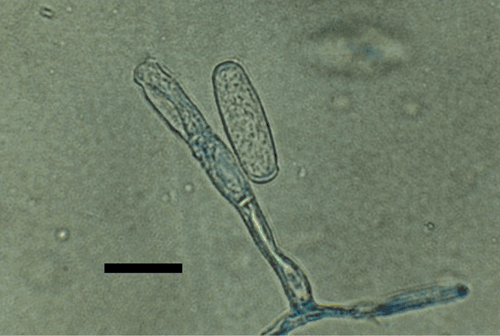First report of anamorphic Erysiphe australiana on Lagerstroemia speciosa in India
Pankaj Baiswar A B , Satish Chandra A and S. V. Ngachan AA ICAR Research Complex for NEH Region, Umiam-793103, Meghalaya, India.
B Corresponding author. Email: pbaiswar@yahoo.com
Australasian Plant Disease Notes 4(1) 49-49 https://doi.org/10.1071/DN09020
Submitted: 27 February 2009 Accepted: 17 April 2009 Published: 13 May 2009
Abstract
Powdery mildew was observed on Lagerstroemia speciosa in North East India in March 2008. This plant is used as an ornamental plant and also for medicinal purposes. Based on morphological characters the pathogen was identified as the anamorph of Erysiphe australiana. This is the first report of this organism causing powdery mildew on L. speciosa in Meghalaya, India.
Lagerstroemia speciosa (L.) Pers. (= Lagerstroemia flos-reginae Retz.) belongs to the family Lythraceae. It is commonly grown as an ornamental shrub in east and north-east India, where it is preferred to L. indica, which is more popular in other parts of India. Extract prepared from leaves is used by tribal communities for treating different human ailments (Singh et al. 2004). Seed meal from this shrub is also used for feeding broiler chickens (Medhi and Ahmed 2001). This species is also of interest to plant breeders since it can hybridise with L. indica.
Powdery mildew symptoms were observed on leaves and twigs of L. speciosa during March 2008 in Barapani, Meghalaya, India (25°30′N and 91°51′E). Symptoms were more prominent on young leaves and twigs as compared with older leaves and twigs. Severe infection resulted in heavy defoliation. Voucher specimen have been deposited in the herbarium HAL (2241 F.), Martin-Luther-Universität, Germany and in the Institute Herbarium of ICAR Research Complex for NEH Region, Umiam, Meghalaya, India (ICARHNEH 25).
Dense white mycelial patches were present on both surfaces of the leaves. Hyphae had multilobed appressoria. Conidiophores consisting of a cylindrical foot cell (22.4– 34.2 × 8.2–10.6 μm) followed by 2–3 shorter cells (Fig. 1). Conidia (29.6–38.4 × 11.8–14.5 μm) were cylindrical and borne singly on the apex of the conidiophores. Fibrosin bodies were absent. Shoulder germination of conidia was also observed. Appressoria on germ tubes were multilobed. Based on these characters the pathogen was identified as the anamorph of Erysiphe australiana (Liberato and Barreto 2004). Chasmothecia (perfect stage) were not observed. Dusting conidia on healthy leaves of detached twigs reproduced symptoms of the disease 8–10 days after inoculation, whereas non-inoculated twigs, used as control, did not develop any symptoms.

|
Previously E. australiana has been reported from North India on L. indica (Paul and Thakur 2006). To our knowledge, this is the first record of powdery mildew of L. speciosa caused by E. australiana in India. This disease is of importance in India since powdery mildew makes these ornamental plants unsightly and also causes heavy defoliation.
Acknowledgement
Authors are grateful to Dr D.K. Hore (Incharge, National Bureau of Plant Genetic Resources, Regional Center, Meghalaya, India) for identification of the host.
Liberato R, Barreto RW
(2004) Anamorphic stage of Erysiphe australiana causing powdery mildew on Lagerstroemia indica in Brazil. Plant Pathology 53, 808.
| Crossref | GoogleScholarGoogle Scholar |

Medhi D, Ahmed HF
(2001) Effect of maize with Ajar seed meal in the diets of broiler chicken on voluntary feed intake and nutrient digestibility. Indian Journal of Animal Nutrition 18, 353–356.

Singh V,
Sinha KP, Kumar N
(2004) Admixture dependent doses prepared from the medicinal plants by “Kol” tribe for treatment of diabetes. National Academy Science Letters 27, 257–260.



